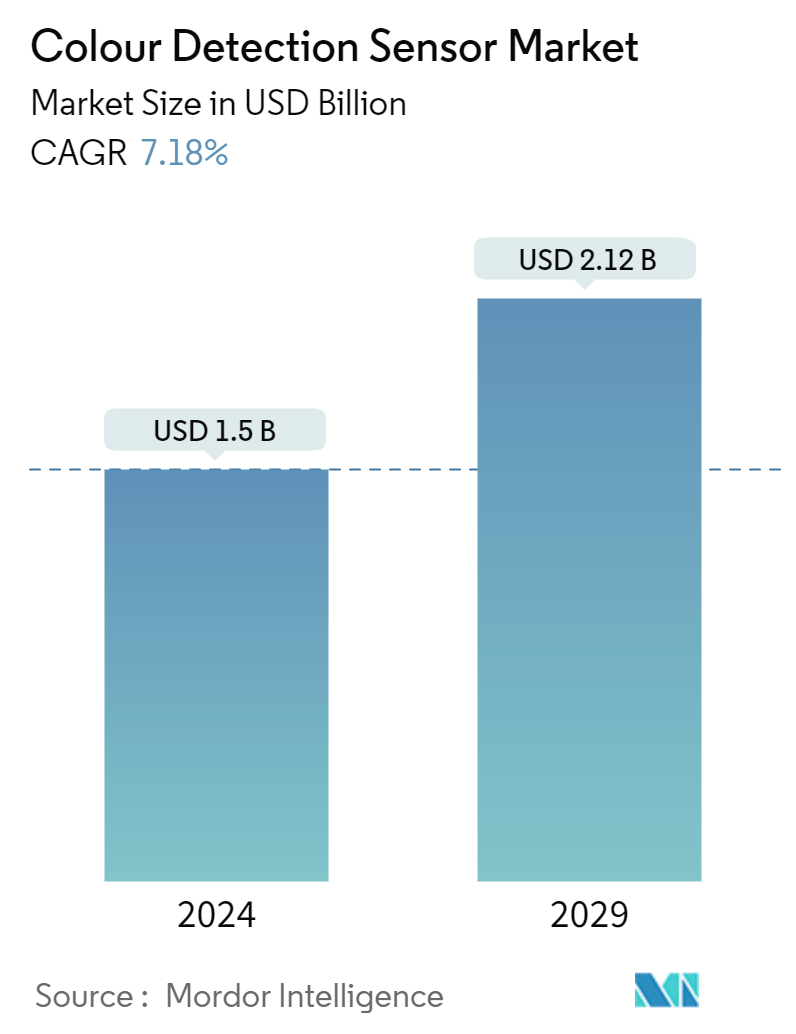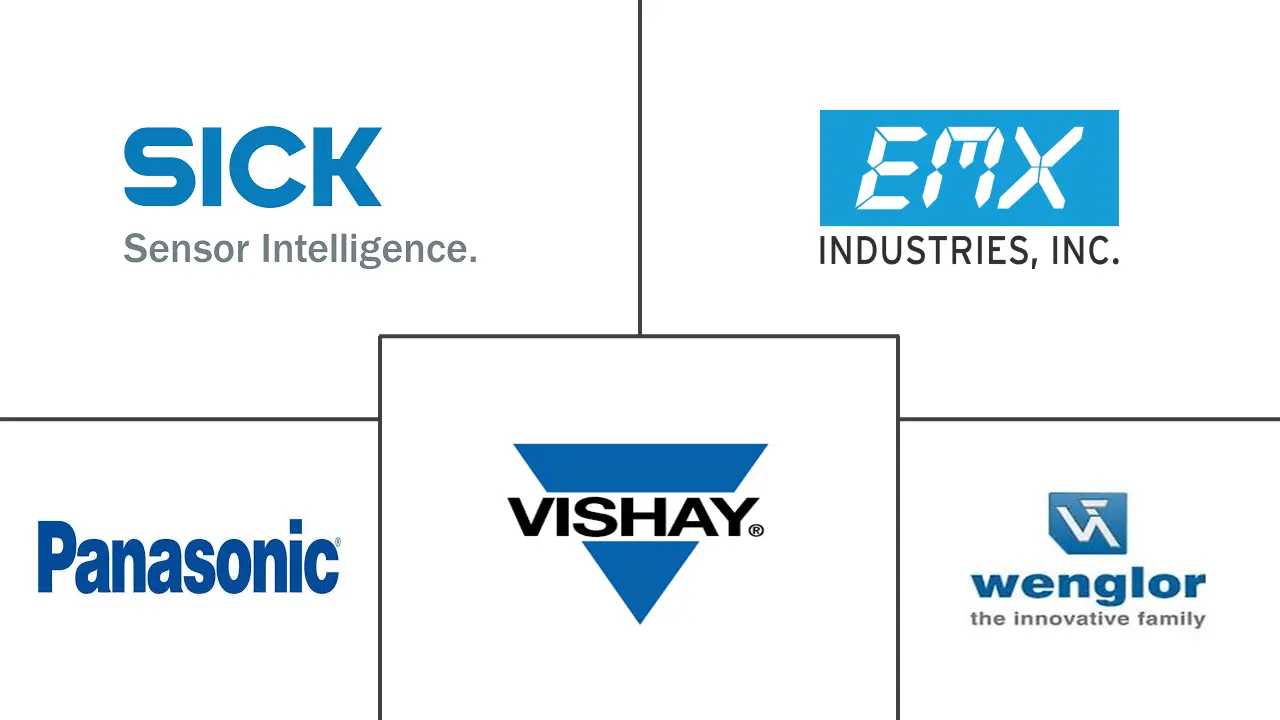Market Size of Colour Detection Sensor Industry

| Study Period | 2019 - 2029 |
| Market Size (2024) | USD 1.5 Billion |
| Market Size (2029) | USD 2.12 Billion |
| CAGR (2024 - 2029) | 7.18 % |
| Fastest Growing Market | Asia Pacific |
| Largest Market | North America |
| Market Concentration | Low |
Major Players
*Disclaimer: Major Players sorted in no particular order |
Color Detection Sensor Market Analysis
The Colour Detection Sensor Market size is estimated at USD 1.5 billion in 2024, and is expected to reach USD 2.12 billion by 2029, growing at a CAGR of 7.18% during the forecast period (2024-2029).
Color detection sensors emit light onto objects and measure the direct reflection or the output. Many of these sensors come equipped with integral light sources, ensuring they achieve the desired effect. These sensors are pivotal in grading-colored products, distinguishing coded markings, and verifying the presence of adhesive or data codes on packages. Their primary applications include true color recognition and color mark detection. Sensors designed for true color recognition must differentiate between colors or shades, often operating in sorting or matching modes.
- Color sensors, utilizing diffuse technology, have been developed to detect a broad spectrum of colors. These sensors employ a combination of color-sensitive filters and an array of sensors to conduct color sensing. This data then analyzes the colors in an image or a specified object. The color measurement process typically involves a light source that illuminates the target surface and a receiver that captures and measures the reflected wavelengths.
- The integration of color sensors in smartphones significantly influences the growth of color detection sensors. Smartphone color sensors distinguish between natural and artificial light, enhancing the functionality of optical lenses in these devices. Integrating color sensors with IoT and AI technologies allows for real-time data analysis and decision-making, further improving their applications.
- Color detection sensors play a crucial role in industries like textiles, ensuring color consistency in production, and are a staple in industrial automation setups. Industries spanning food and beverages, commercial and consumer printing, consumer electronics, automotive, pharmaceuticals, healthcare, and chemicals use these sensors increasingly to identify even the subtlest color variations.
- The high initial costs are one factor restricting the growth of the color detection market. While color detection sensors offer numerous benefits, including ensuring quality control and consistency during manufacturing processes and enhancing accuracy and reliability in color detection, their cost can be a barrier to adoption.
- While the pandemic's impact has waned, the allure of automation and robotics remains strong, prompting diverse industries to ramp up investments in these technologies. According to IFR, the global installation of industrial robots is set to surge in the coming years. 2026 installations will reach 718 thousand units, up from 553 thousand units in 2022. This growth trajectory paints a promising picture for the market studied, particularly as color sensors gain prominence as vital elements in automation setups, notably in sectors like packaging, automotive, textiles, and healthcare.
Color Detection Sensor Industry Segmentation
A color detection sensor detects the material's colors, primarily in the RBG scale. These sensors detect the color with the help of a light source that illuminates the material surface. A surface whose color has to be detected is required, and then a receiver measures the reflected wavelengths to give the result of the detected color. These sensors are applied to measure and detect the color of various surfaces. These sensors have multiple applications, including industrial, medical, automotive, etc. There are different types of color detection sensors, such as brightness, contrast, luminescence, RGB, and print mark sensors.
The color detection sensor market is segmented by type (brightness sensor, molecular luminescence sensor, RGB sensor, and print mark sensor), end-user industry (food and beverage, healthcare, chemical, textile, automotive, consumer electronics, and other end-user industries), and geography (North America, Europe, Asia, Australia and New Zealand, Latin America, and Middle East & Africa). The report offers the market size in value terms in USD for all the abovementioned segments.
| By Type | |
| Brightness Sensor | |
| Molecular Luminescence Sensor | |
| RGB Sensor | |
| Printed Mark Sensor |
| By End-user Industry | |
| Food and Beverage | |
| Healthcare | |
| Chemical | |
| Textile | |
| Automotive | |
| Consumer Electronics | |
| Other End-user Industries |
| By Geography*** | |
| North America | |
| Europe | |
| Asia | |
| Australia and New Zealand | |
| Latin America | |
| Middle East & Africa |
Colour Detection Sensor Market Size Summary
The color detection sensor market is poised for significant growth, driven by its critical applications across various industries. These sensors, which emit light and measure the reflection to detect colors, are essential in processes such as grading colored products, verifying codes, and ensuring color consistency in manufacturing. Their integration into industries like textiles, food and beverages, automotive, and healthcare underscores their importance in maintaining quality and efficiency. The adoption of color detection sensors is further bolstered by advancements in IoT and AI technologies, enabling real-time data analysis and enhancing their functionality in automation setups. Despite the high initial costs posing a challenge, the demand for these sensors continues to rise as industries increasingly recognize their value in quality control and process optimization.
The market landscape is characterized by a fragmented structure with numerous players, including prominent companies like SICK AG, EMX Industries Inc., and Panasonic Corporation, which are continuously innovating to enhance sensor capabilities. The United States leads the market, benefiting from its stronghold in industrial automation and the presence of key market players. Recent developments, such as SICK AG's introduction of high-resolution color sensors and Balluff GmbH's new production facility in Mexico, highlight the ongoing advancements and strategic expansions within the market. As industries continue to invest in automation and robotics, the color detection sensor market is expected to experience robust growth, driven by the increasing need for precision and efficiency in various applications.
Colour Detection Sensor Market Size - Table of Contents
-
1. MARKET INSIGHTS
-
1.1 Market Overview
-
1.2 Industry Attractiveness - Porter's Five Forces Analysis
-
1.2.1 Bargaining Power of Suppliers
-
1.2.2 Bargaining Power of Buyers
-
1.2.3 Threat of New Entrants
-
1.2.4 Threat of Substitute Products and Services
-
1.2.5 Intensity of Competitive Rivalry
-
-
1.3 Industry Value Chain Analysis
-
1.4 Technology Snapshot
-
1.4.1 Industrial Automation
-
1.4.2 Consumer Electronics
-
1.4.3 Fluid and Gas Analysis
-
1.4.4 Lighting and Digital Signage
-
-
-
2. MARKET SEGMENTATION
-
2.1 By Type
-
2.1.1 Brightness Sensor
-
2.1.2 Molecular Luminescence Sensor
-
2.1.3 RGB Sensor
-
2.1.4 Printed Mark Sensor
-
-
2.2 By End-user Industry
-
2.2.1 Food and Beverage
-
2.2.2 Healthcare
-
2.2.3 Chemical
-
2.2.4 Textile
-
2.2.5 Automotive
-
2.2.6 Consumer Electronics
-
2.2.7 Other End-user Industries
-
-
2.3 By Geography***
-
2.3.1 North America
-
2.3.2 Europe
-
2.3.3 Asia
-
2.3.4 Australia and New Zealand
-
2.3.5 Latin America
-
2.3.6 Middle East & Africa
-
-
Colour Detection Sensor Market Size FAQs
How big is the Colour Detection Sensor Market?
The Colour Detection Sensor Market size is expected to reach USD 1.5 billion in 2024 and grow at a CAGR of 7.18% to reach USD 2.12 billion by 2029.
What is the current Colour Detection Sensor Market size?
In 2024, the Colour Detection Sensor Market size is expected to reach USD 1.5 billion.

